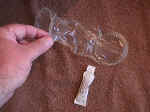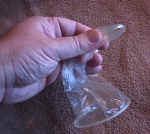|
|
Operational Obstetrics & Gynecology
Female Condom
Female condoms can be very effective in preventing pregnancy and providing reasonable protection against some sexually transmitted diseases.
 Each female condom is individually packaged and pre-lubricated. It is made out of
plastic, not latex, so it is particularly useful for women and men with latex allergies.
Each package contains an extra small tube of lubricant.
Each female condom is individually packaged and pre-lubricated. It is made out of
plastic, not latex, so it is particularly useful for women and men with latex allergies.
Each package contains an extra small tube of lubricant.
After removal of the condom from its' package, the inner ring is compressed into an oval shape. The inner ring is then inserted deeply into the vagina, so that it encircles the cervix. With proper positioning, the exterior ring will cover the vulva and remain outside the vagina.
 During intercourse, the penis is inserted through the outer ring into the vagina. It is
a good idea to hold the outer ring in place while the penis is initially inserted.
During intercourse, the penis is inserted through the outer ring into the vagina. It is
a good idea to hold the outer ring in place while the penis is initially inserted.
After intercourse, the outside ring is twisted to seal the semen inside the condom. Then the condom can be gently pulled straight out. It should be discarded in a trash container and not flushed, as it may clog the toilet.
Although pre-lubricated, women may find they need additional lubrication. Some women can feel the condom inside the vagina and others cannot. Extra lubrication can be helpful if this sensation is a distraction.
 Some women find that intercourse while using the female condom produces distracting
sounds. In this case, the use of additional lubricant can be helpful in silencing the
noise.
Some women find that intercourse while using the female condom produces distracting
sounds. In this case, the use of additional lubricant can be helpful in silencing the
noise.
Additional spermicide (cream, foam or jelly) can be used safely with the female condom, although the degree to which this provides additional contraceptive effect is unknown. If extra spermicide is to be used, it is most likely to be helpful if placed in the vagina prior to insertion of the female condom.
The effectiveness of the female condom in preventing pregnancy is roughly the same as the use of a diaphragm. When used carefully and consistently with each episode of intercourse, there will be about 5 failures per 100 women per year (95% effective). When all women who use this method are evaluated, including those whose use is not always careful and not necessarily consistent, the annual failure rate (pregnancy rate) is about 20%.
Home · Introduction · Medical Support of Women in Field Environments · The Prisoner of War Experience · Routine Care · Pap Smears · Human Papilloma Virus · Contraception · Birth Control Pills · Vulvar Disease · Vaginal Discharge · Abnormal Bleeding · Menstrual Problems · Abdominal Pain · Urination Problems · Menopause · Breast Problems · Sexual Assault · Normal Pregnancy · Abnormal Pregnancy · Normal Labor and Delivery · Problems During Labor and Delivery · Care of the Newborn
|
Bureau of Medicine
and Surgery |
Operational
Obstetrics & Gynecology - 2nd Edition |
 This
web version of Operational Obstetrics & Gynecology is provided by
The Brookside Associates
Medical Education Division. It contains original contents from the
official US Navy NAVMEDPUB 6300-2C, but has been reformatted for web access and
includes advertising and links that were not present in the original version.
This web version has not been approved by the Department of the Navy or the
Department of Defense. The presence of any advertising on these pages does not
constitute an endorsement of that product or service by either the Department of
Defense or the Brookside Associates. The Brookside Associates is a private
organization, not affiliated with the United States Department of Defense. All
material in this version is unclassified.
This
web version of Operational Obstetrics & Gynecology is provided by
The Brookside Associates
Medical Education Division. It contains original contents from the
official US Navy NAVMEDPUB 6300-2C, but has been reformatted for web access and
includes advertising and links that were not present in the original version.
This web version has not been approved by the Department of the Navy or the
Department of Defense. The presence of any advertising on these pages does not
constitute an endorsement of that product or service by either the Department of
Defense or the Brookside Associates. The Brookside Associates is a private
organization, not affiliated with the United States Department of Defense. All
material in this version is unclassified.
This formatting © 2006
Medical Education Division,
Brookside Associates, Ltd.
All rights reserved